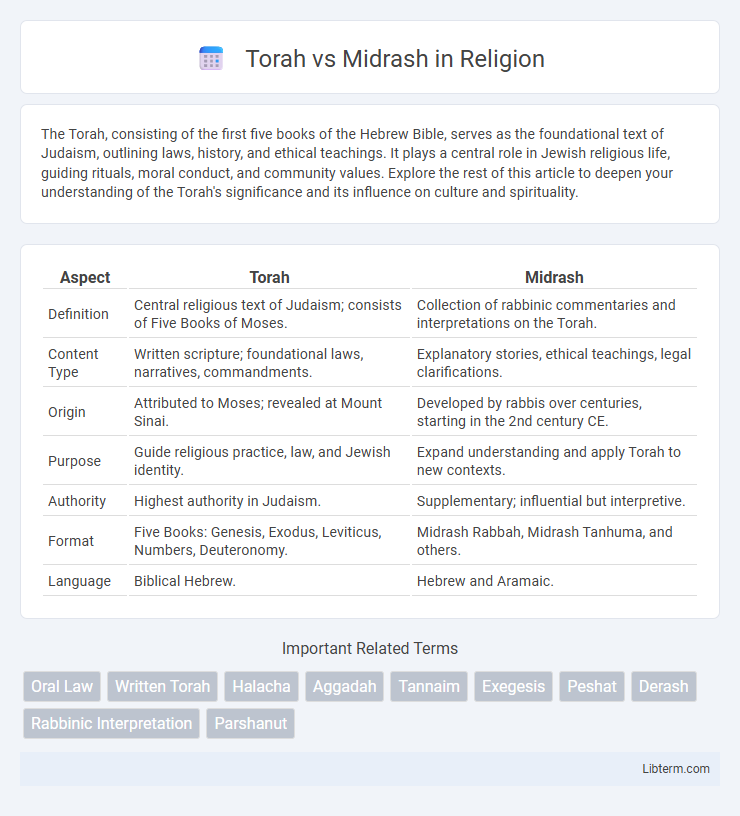The Torah, consisting of the first five books of the Hebrew Bible, serves as the foundational text of Judaism, outlining laws, history, and ethical teachings. It plays a central role in Jewish religious life, guiding rituals, moral conduct, and community values. Explore the rest of this article to deepen your understanding of the Torah's significance and its influence on culture and spirituality.
Table of Comparison
| Aspect | Torah | Midrash |
|---|---|---|
| Definition | Central religious text of Judaism; consists of Five Books of Moses. | Collection of rabbinic commentaries and interpretations on the Torah. |
| Content Type | Written scripture; foundational laws, narratives, commandments. | Explanatory stories, ethical teachings, legal clarifications. |
| Origin | Attributed to Moses; revealed at Mount Sinai. | Developed by rabbis over centuries, starting in the 2nd century CE. |
| Purpose | Guide religious practice, law, and Jewish identity. | Expand understanding and apply Torah to new contexts. |
| Authority | Highest authority in Judaism. | Supplementary; influential but interpretive. |
| Format | Five Books: Genesis, Exodus, Leviticus, Numbers, Deuteronomy. | Midrash Rabbah, Midrash Tanhuma, and others. |
| Language | Biblical Hebrew. | Hebrew and Aramaic. |
Introduction to Torah and Midrash
The Torah, comprising the first five books of the Hebrew Bible, serves as the foundational text of Jewish law, history, and ethics, traditionally attributed to Moses. Midrash represents a vast body of rabbinic literature that interprets, explains, and expands upon the Torah's narratives and commandments, often exploring deeper moral and spiritual lessons. While the Torah provides the core scriptural content, Midrash functions as a dynamic commentary that contextualizes and illuminates the text for evolving generations.
Defining the Torah
The Torah, consisting of the Five Books of Moses, serves as the foundational sacred text of Judaism, outlining laws, commandments, and historical narratives essential to Jewish faith and practice. It is considered divinely revealed and authoritative, forming the basis for religious observance and ethical guidance. Midrash comprises interpretive commentaries and expansions that elucidate, explain, and explore deeper meanings within the Torah's verses.
Understanding the Midrash
The Midrash offers an expansive collection of Jewish biblical exegesis that complements and elaborates on the Torah by exploring deeper meanings and ethical teachings through parables, stories, and legal interpretations. Unlike the Torah's direct narrative and commandments, the Midrash delves into the text's underlying layers, providing context and filling gaps with imaginative insights drawn from rabbinic tradition. This dynamic interpretation fosters a richer understanding of scripture, emphasizing the relationship between divine law and lived experience.
Historical Origins and Development
The Torah, central to Jewish tradition, comprises the first five books of the Hebrew Bible, traditionally attributed to Moses and dating back to the 13th century BCE. Midrash emerged later, around the 2nd century CE, as a method of interpreting and expanding upon the Torah's text, blending legal, ethical, and narrative elements to address evolving religious and social contexts. Both serve complementary roles, with the Torah as the foundational scripture and Midrash as a dynamic exegetical tradition that deepened biblical understanding throughout Jewish history.
Literary Structure and Format
The Torah, composed of five books, follows a primarily narrative and legal framework with a linear progression and structured commandments. Midrash employs a diverse literary format, including homilies, stories, and interpretive expansions that elaborate on and explore the Torah's text beyond its plain meaning. The Torah's format emphasizes legal codes and historical narrative, while Midrashic literature offers thematic and exegetical depth through varied storytelling techniques.
Purposes and Functions
The Torah serves as the foundational scriptural text of Judaism, providing divine laws, narratives, and commandments essential for religious practice and ethical guidance. Midrash functions as a complementary interpretive commentary that explores deeper meanings, clarifies ambiguities, and expands on the Torah's teachings through stories, parables, and legal exegesis. While the Torah establishes core doctrines, Midrash enriches understanding by connecting textual insights to contemporary life and spiritual lessons.
Interpretation and Authority
The Torah, comprising the Five Books of Moses, serves as the foundational legal and narrative text in Judaism, regarded as divinely revealed and authoritative. Midrash consists of rabbinic commentaries and homiletic interpretations that expand on the Torah's verses, offering deeper insights and ethical lessons while addressing textual ambiguities. Whereas the Torah holds canonical authority as scripture, Midrash functions as an interpretative tradition that guides understanding and application of the Torah's laws and stories within Jewish thought.
Key Differences Between Torah and Midrash
The Torah, consisting of the Five Books of Moses, is the foundational sacred text of Judaism containing the core laws and narratives, while the Midrash comprises rabbinic commentaries and interpretations that explore and expound upon the Torah's deeper meanings. Unlike the Torah, which is considered divinely revealed scripture, Midrashim are rabbinic teachings that often use stories, parables, and legal discussions to clarify ambiguities and elaborate on biblical verses. The key difference lies in the Torah's status as the authoritative written law and the Midrash's role as interpretive literature designed to provide theological, ethical, and legal insights beyond the literal text.
Impact on Jewish Thought and Practice
The Torah provides the foundational text for Jewish law, ethics, and theology, shaping core beliefs and daily religious practices. Midrash offers interpretive narratives and expansions on the Torah, enriching understanding through allegory and deeper moral insights. Together, they create a dynamic interplay that continuously influences Jewish thought, ritual observance, and cultural identity.
Conclusion: Torah and Midrash in Contemporary Judaism
Torah serves as the foundational text of Judaism, providing direct commandments and historical narratives, while Midrash offers interpretative insights that expand and elucidate the Torah's meaning. In contemporary Judaism, the Midrash enriches religious practice by connecting ancient teachings to modern ethical and spiritual questions. This dynamic interplay ensures that Judaism remains a living tradition, continually adapted through ongoing study and interpretation.
Torah Infographic

 libterm.com
libterm.com